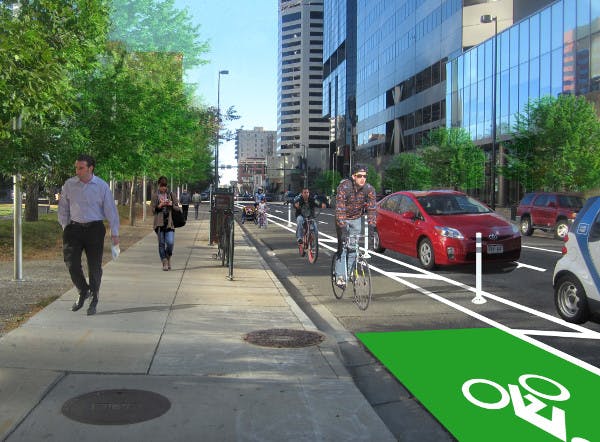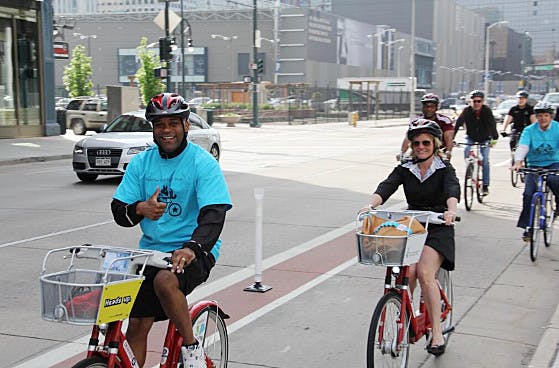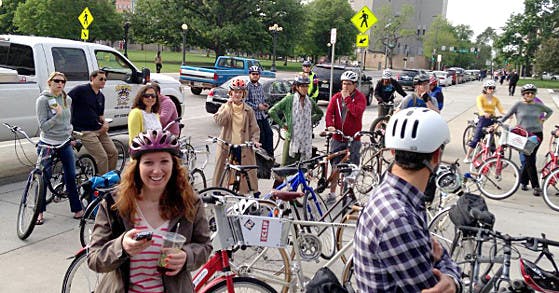How Denver got an oil company to help crowdfund a protected bike lane
By: Michael Andersen, Green Lane Project staff writer

Need money for a better bike lane? Try asking the Internet.
A year after a neighborhood enhancement group in Memphis turned heads around the country by raising $70,000 for a new protected bike lane using the crowdfunding site Ioby.org, business leaders in Colorado’s capital are following suit.
The Downtown Denver Partnership launched its campaign Oct. 28 with a breakfast event and a detailed plan to raise $36,000 online from corporate and individual donors to help pay for planning and design of a protected bike lane on Arapahoe Street.
With crowdfunded bike facilities becoming a new trend, we wanted to get some tips on how to run a good campaign. Here’s an analysis of what this project’s mastermind, DDP senior manager Aylene McCallum, told us about how they did it.

1) The lane being crowdfunded is relatively uncomplicated
Denver’s first protected bike lane, 15th Street, opened in May. A parallel route is expected in the other direction, on 14th, next year, as is a perpendicular route on Lawrence Street.
Arapahoe is parallel to Lawrence and one block northwest. When complete, the four streets will form a basic grid of all-ages on-street connections between Denver’s university district and much of downtown.
With three wide travel lanes, two parking lanes and an existing bike lane, Arapahoe also has plenty of street space already, making it a politically easy proposal to add a buffer and barrier.
“In the grand scheme of things, it’s pretty easy to add the vertical protection,” McCallum said.
2) Crowdfunding isn’t expected to pay for the entire project
The single largest funder of the Arapahoe planning effort will be the Denver-based Gates Family Foundation, which kicked off the fundraising process with $85,000 of its own.
“They recently had moved into downtown Denver and were looking to make investments to improve downtown,” McCallum said.
The Downtown Denver Business Improvement District chipped in another $35,000.
Finally, the city government pledged to cover construction costs on Arapahoe if the private sector could come up with the remaining $35,000 in design costs.

3) Crowdfunding is as much about creating a narrative as it is about raising money
When community members are opening their wallets to raise tens of thousands of dollars for public infrastructure, it’s hard for anyone to argue that a project lacks public support.
“Maybe we could have gone to get the other $35,000 from another private grantmaking organization or another quasi-governmental organization, but we really wanted to get the public involved,” McCallum said.
Crowdfunding efforts get attention, she says.
“It’s individual employees in downtown and it’s individual businesses in downtown — it’s their opportunity to say, ‘This matters to me,'” McCallum said. “‘It’s so important to me that I’m willing to put some money down in hopes that the city will follow suit.'”
A classic bit of fundraising wisdom is also at work with Arapahoe: people who open their wallets for a project become more invested in its further success.
“We kind of always wanted to have the public and the community involved to increase buy-in,” McCallum said.

4) Organizers framed the campaign as a benefit for the whole city
Using private donations to unlock public investment raises questions of fairness. If crowdfunding campaigns became common, will cities build even less infrastructure in poorer neighborhoods?
McCallum says it’ll have the opposite effect: better biking facilities downtown will spread the idea elsewhere.
“People throughout the city come to downtown Denver, they experience what it’s like to ride in protected bike lanes in downtown Denver, and they say, ‘Oh, I want this in my neighborhood,'” she said.
5) The campaign assigned an experienced fundraiser to the job months before the launch
Another key component of the campaign is McCallum herself — someone with experience soliciting donations and relationships with potential donors.
“You can’t raise money unless you ask people to give you money,” McCallum said. “I think the No. 1 step is coming up with a really solid list of people you can ask. And really thinking critically about why should these people give you money?”
McCallum scored one of the highest-profile pledges to the Arapahoe plan, $2,500 from oil company Anadarko, just by asking a supporter there for advice on who else to ask for money.
“He is a bicyclist himself, and they have quite a bicycling culture in that organization,” McCallum said of her contact at Anadarko. “He called me back within five minutes and said, ‘Are you kidding? Sign us up.'”
McCallum said it’s become conventional wisdom among downtown Denver employers that better bike infrastructure is needed.
“It’s because their employees are biking to work and the people they want to hire are biking to work,” she said. “When I started working at the partnership, the No. 1 question we were getting was ‘Where are my employees going to park downtown? And that has slowly shifted to ‘Where is the closest bike lane to my office?'”
“People still ask about parking, but it is not as critical a decision point for businesses,” she said.
6) The lead fundraiser has personally experienced great bike infrastructure
McCallum has herself been bike commuting for years, but she became a major supporter of protected bike lanes after seeing them in action.
“I think I became sold when a small group of us went to NYC in 2010 to see these protected bike lanes,” McCallum said. “I remember vividly: it was midtown Manhattan, it was crazy traffic. And we turned off of an unprotected facility onto a protected facility. And I just got so much calmer.”
And these days, she has another reason to support protected lanes.
“I also have two kids now, so I want protected facilities out there so they feel safer, and so that they are safer, riding the streets of Denver as they grow up,” she said.
